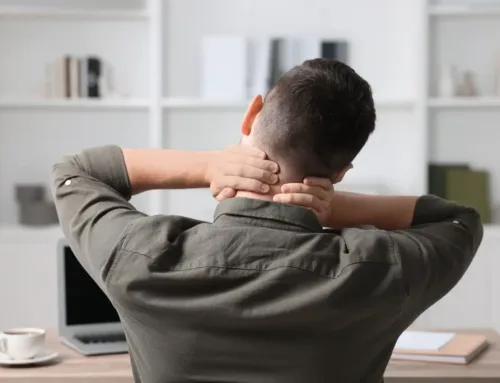
A bulging disc occurs when the outer layer of an intervertebral disc, which acts as a cushion between the vertebrae, weakens and allows the inner gel-like substance to protrude. This can put pressure on nearby nerves, which can lead to pain and discomfort. Unlike a herniated disc, where the inner substance leaks out, a bulging disc remains within the outer layer but still causes significant issues.
Symptoms of a Bulging Disc
Symptoms of a bulging disc depend on its severity and location in the spine. You may experience:
- Back pain: This is often the first sign of a bulging disc and can range from mild to severe.
- Sciatica: A bulging disc can press on the sciatic nerve and cause sharp pain that radiates down one leg.
- Numbness or tingling: These sensations often occur in the arms or legs if the bulging disc is pressing on a nerve.
- Reduced mobility: A bulging disc can cause difficulty in bending, twisting, or performing everyday activities.
- Weakness: Muscles in the affected area weaken, which affects your ability to lift or hold items.
Causes of a Bulging Disc
Several factors can contribute to the development of a bulging disc, including:
- Aging: As we age, the spinal discs lose water content and become less flexible. This makes them more susceptible to bulging.
- Poor posture: Improper body positioning when sleeping, sitting, standing, or exercising can cause a bulging disc.
- Obesity: Excess body weight stresses the spine and increases the likelihood of disc issues.
- Injury: Trauma from accidents, falls, or heavy lifting can cause the discs to bulge.
- Repetitive strain: Continuous strain on the disc from injury or heavy lifting can wear them down throughout the years.
Chiropractic Care
Chiropractic care is a non-invasive and effective way to manage bulging disc symptoms and promote healing. Here’s how chiropractic care can help:
Spinal Adjustments
Chiropractors perform spinal adjustments by applying a controlled, sudden force to the spinal joint with their hands or a small instrument. These adjustments alleviate pain, enhance spinal motion, and improve the body’s physical function.
Decompression Therapy
This chiropractic technique relieves nerve pressure by gently stretching out the affected area. Decompression therapy creates a negative pressure within the disc, which encourages the bulging nerve to retract.
Soft Tissue Therapy
Through soft tissue therapy, chiros can manage, manipulate, and rehabilitate the body’s soft tissues, including muscles, ligaments, and tendons. This therapy improves blood flow and promotes healing.
Lifestyle Advice
Chiros can also provide lifestyle and ergonomics advice to prevent further disc-related issues. This can be guidance on posture, weight management, core exercises, and safe lifting techniques.
Exercises and Tips for Prevention and Self-Care
Some exercises and self-care practices may help relieve bulging disc symptoms and prevent future issues.
Core Strengthening Exercises
Strengthening the core muscles can provide better support for the spine and reduce the risk of disc issues. Effective exercises include:
- Planks: Hold a plank position for 20-30 seconds, gradually increasing the duration as strength improves.
- Bridges: Lie on your back with knees bent and feet flat on the floor. Lift your hips towards the ceiling, hold for a few seconds, and lower back down.
- Bird-dogs: Start on all fours, extend one arm and the opposite leg simultaneously, hold for a few seconds, and switch sides.
Flexibility and Stretching
Maintaining flexibility can help reduce strain on the spine. Include stretches such as:
- Hamstring stretches: Sit on the floor with your legs extended. Reach towards your toes, and hold the stretch for 20-30 seconds.
- Cat-cow stretches: On all fours, alternate between arching your back (cat) and dipping it towards the floor (cow).
Self-Care Tips
- Maintain good posture: Avoid slouching when sitting or standing.
- Stay active: Regular physical activity can help maintain a healthy weight and strengthen the spine.
- Use proper lifting techniques: Bend at the knees, not the waist, when lifting heavy objects.
- Stay hydrated: Drink plenty of water to keep the spinal discs hydrated and flexible.
Consider scheduling an appointment with Our Chiro Brisbane if you’re experiencing bulging disc symptoms. Our experienced chiropractors can provide personalised care to help alleviate pain, improve body function, and promote spinal health. Don’t let a bulging disc hold you back — take the first step towards a healthier, pain-free life today!
Our Chiro Brisbane is a friendly, local chiropractic clinic serving Bowen Hills, Fortitude Valley, New Farm, Newstead, Teneriffe, and surrounding areas.
REFERENCES:
https://www.medicalnewstoday.com/articles/bulging-disk-in-back#what-it-is
https://www.healthcentral.com/condition/back-pain/bulging-disc
https://www.webmd.com/back-pain/spinal-decompression-therapy-surgical-nonsurgical






